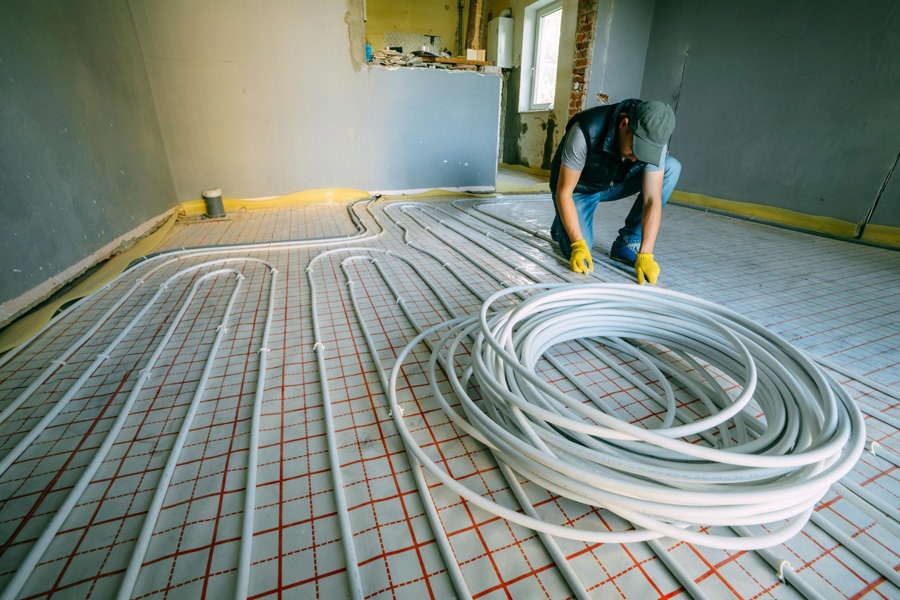Renovation Projects: Retrofitting Your Home with Electric Floor Heating

Image Source: www.thefloorheatingwarehouse.co.uk
Renovating a home presents an excellent opportunity to improve comfort, energy efficiency, and overall living experience. One increasingly popular renovation option is retrofitting your home with electric floor heating. This modern heating solution offers a range of benefits, from consistent warmth to enhanced energy efficiency. In this blog post, we will explore the key considerations, benefits, and steps involved in retrofitting your home with electric floor heating, while also touching upon how it compares to water underfloor heating systems.
Why Choose Electric Floor Heating?
Comfort and Warmth:
Electric floor heating systems provide even and consistent heat distribution, eliminating cold spots and creating a cozy atmosphere. Unlike traditional radiators that heat the air unevenly, electric floor heating warms the entire floor surface, ensuring that heat rises naturally and uniformly.
Energy Efficiency:
Electric floor heating can be an energy-efficient option, especially when paired with a well-insulated home. Modern electric heating systems come with programmable thermostats, allowing you to control the temperature and reduce energy consumption when heating is not needed.
Ease of Installation:
Retrofitting your home with electric floor heating is relatively straightforward compared to other heating solutions. Electric systems involve laying heating cables or mats under the floor covering, making them suitable for various floor types, including tile, laminate, and hardwood. This ease of installation makes them an attractive option for renovation projects.
Key Considerations for Retrofitting
Floor Type and Insulation:
Before installing electric floor heating, assess your existing floor type and insulation. Proper insulation is crucial to maximize the efficiency of the heating system and prevent heat loss. If your home lacks adequate insulation, consider upgrading it as part of the renovation.
Electrical Capacity:
Ensure that your home’s electrical system can handle the additional load of electric floor heating. Consult a licensed electrician to evaluate your electrical capacity and make any necessary upgrades to support the new heating system.
Room Suitability:
Electric floor heating is versatile and can be installed in various rooms, including bathrooms, kitchens, and living areas. However, it’s important to consider the specific heating needs of each room. For example, bathrooms may benefit from electric heating due to their smaller size and the comfort of warm floors underfoot.
Installation Steps
1. Planning and Design:
Start by planning the layout and design of the electric floor heating system. Determine the areas where you want to install the heating and calculate the required heating mat or cable length. Ensure that the system will cover the intended floor space evenly.
2. Prepare the Subfloor:
Prepare the subfloor by cleaning it thoroughly and ensuring it is smooth and dry. Any irregularities in the subfloor can affect the performance of the heating system.
3. Install Insulation Boards:
Install insulation boards to enhance the efficiency of the electric floor heating system. These boards help to reflect heat upwards, preventing heat loss through the subfloor.
4. Lay the Heating Mats or Cables:
Carefully lay the heating mats or cables according to the manufacturer’s instructions. Ensure that they are evenly spaced and securely fixed to the subfloor.
5. Connect the Thermostat:
Connect the heating mats or cables to the thermostat, which will control the temperature of the system. Follow all safety guidelines and consult a professional electrician if needed.
6. Install the Floor Covering:
Finally, install your chosen floor covering over the heating system. Ensure that the floor covering is compatible with electric floor heating to prevent any damage or reduced efficiency.
Comparing Electric and Water Underfloor Heating
While electric floor heating offers numerous advantages, it’s important to compare it with water underfloor heating systems to make an informed decision.
Water Underfloor Heating:
Water underfloor heating involves circulating warm water through pipes installed under the floor. This system is highly efficient and can be integrated with renewable energy sources such as solar panels or heat pumps. However, it is more complex and costly to install, making it more suitable for new builds or major renovations rather than retrofits.
Electric Underfloor Heating:
Electric underfloor heating, on the other hand, is easier and less expensive to install, making it ideal for retrofit projects. It provides quick and efficient heating, but its operating costs can be higher depending on electricity prices and the system’s usage.
Conclusion
Retrofitting your home with electric floor heating is a practical and efficient way to enhance comfort and energy efficiency during your renovation project. By considering factors such as floor type, insulation, and electrical capacity, you can ensure a successful installation. While both water and electric underfloor heating systems have their merits, electric floor heating stands out for its ease of installation and versatility in retrofit applications. Embrace this modern heating solution to enjoy warm, cozy floors and a more comfortable home environment.








